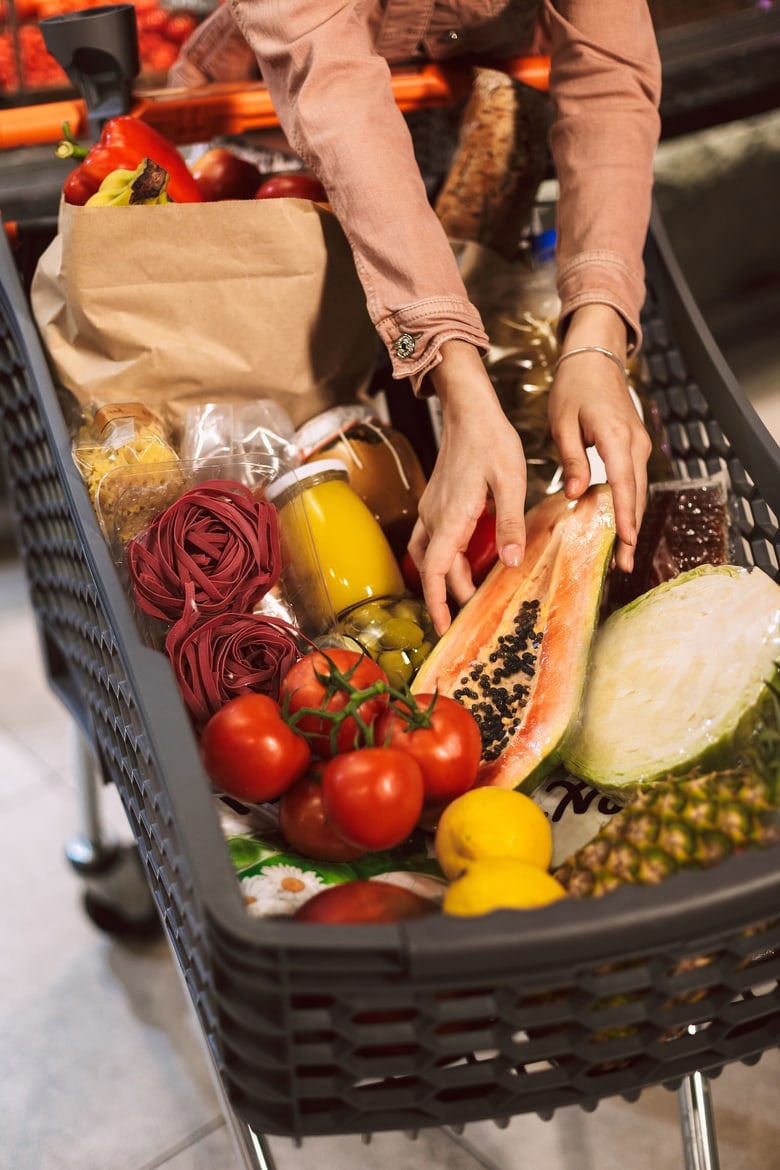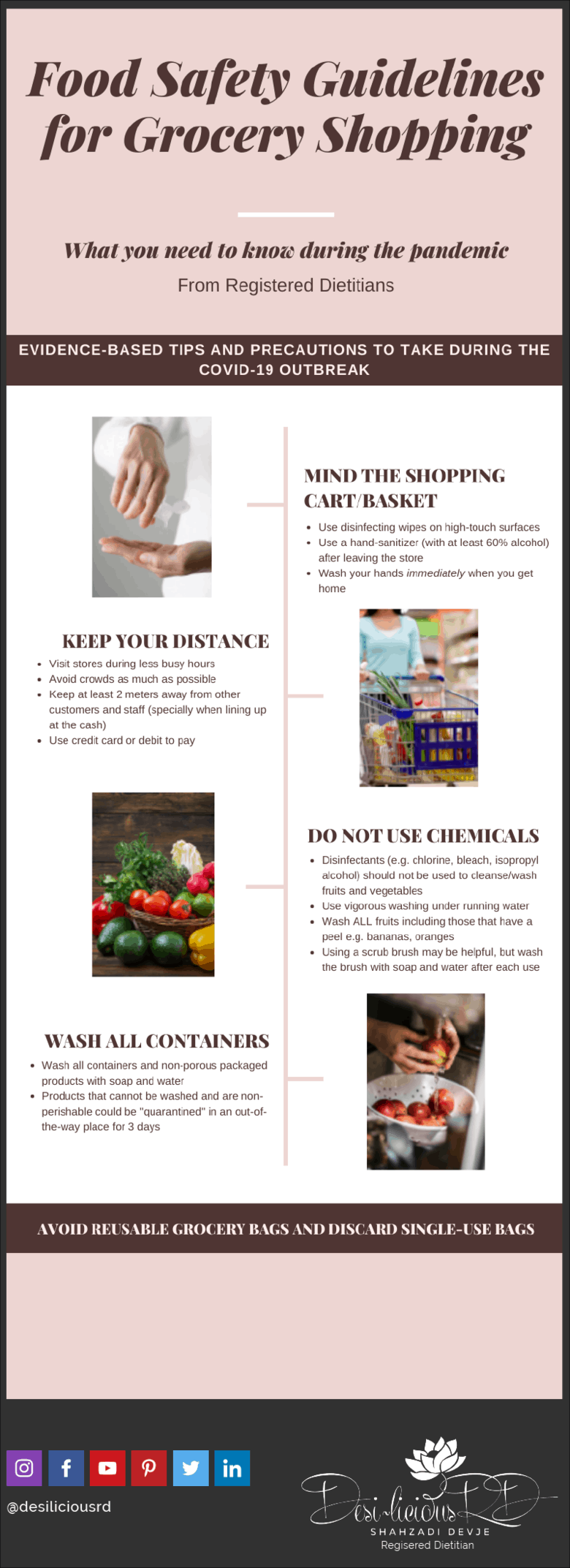No matter what a viral YouTube video tells you, you don’t need to sanitize your fruits and vegetables. Here are evidence-based tips for grocery shopping safely during the COVID-19 outbreak – from registered dietitians.

Amidst the COVID-19 pandemic, grocery shopping is understandably a cause of stress and anxiety for many of us. When at the store, touching surfaces and objects such as shopping carts, freezer door handles, and grocery items are inevitable. You may be asking yourself if you need to disinfect your groceries? Is it okay to use reusable bags? Could the virus be transmitted from objects and food? These are all valid questions, considering the grocery store is such a high-touch space with possible risk.
The good news is, there are no documented cases of COVID-19 that indicate viral transmission through food. However, given that COVID-19 can survive on surfaces for some time, theoretically, it is possible to pick up the virus if you touch a surface or an item someone infected has coughed or sneezed on. While grocery chains have ramped up cleaning and sanitation measures to keep customers safe, it is essential that we also maintain proper hygiene when grocery shopping.
How to grocery shop safely during the COVID-19 outbreak
Mind the shopping cart/basket/food packaging
The shopping cart, basket and food packaging carry a certain level of risk. Bear in mind; it depends on the amount of virus deposited on surfaces as well as the dose you are exposed to.
According to estimates, from the New England Journal of Medicine, the virus remains viable on hard surfaces – making these potentially high-risk surfaces
- Plastic and steel, for up to 3 days,
- Cardboard, for 24 hours
- Copper, for four hours
It makes sense then, as a best practice measure, to use disinfecting wipes to clean high-touch surfaces of the shopping cart or basket. Remember to discard used wipes immediately after use. Alternatively, you could wear disposable gloves, but we wouldn’t recommend this for several reasons. Latex gloves could soon be in short supply for healthcare workers – who need them most. Plus, they are not durable and designed for everyday activities, like grocery shopping. There is a high risk they could rip.
What’s really important is to use a hand sanitizer with at least 60% alcohol, as you leave the store and wash your hands immediately when you get home after your grocery trip.
What about packaged foods and containers? From what we know currently, you could set aside non-perishable groceries for three days before using them.
All that said, let’s not forget that, according to the Centers for Disease Control and Prevention (CDC), the transmission of the virus is far more likely to spread through respiratory droplets from an infected person and much less likely via surfaces or food.
Keep your distance when grocery shopping
Though stores are not as crowded as they used to be before the pandemic, it is vital to keep a safe distance between yourself and fellow shoppers. Consider keeping a minimum distance of two meters away from other customers and staff. You want to be especially mindful of this one when lining up at the cash. Plus, use a credit or debit card at the checkout. That way, you limit the amount of contact handing and receiving money. Also, use your own pen to sign receipts. It’s also a good idea to visit stores during less busy hours to avoid crowds as much as possible.
If you’re anxious, consider bagging your groceries yourself to minimize touching by the store clerk.
Do not use chemicals on produce

It is not safe to use disinfectants such as bleach, chlorine or isopropyl alcohol when washing fruits and vegetables. Neither is it a good idea to use disinfecting wipes to clean your produce. The use of any of these products could be harmful to the body and cause digestive problems. Unfortunately, natural products such as vinegar are not effective at killing the virus. To that end, the best strategy for cleaning fresh produce is vigorous washing under running water.
Despite what you’ve been hearing about washing food with soap and water, remember this: the USDA advises that we should not wash fruits and vegetables with detergent or soap because these are not approved or labelled by the U.S. Food and Drug Administration (FDA) for use on foods. There’s a chance that you could ingest soap or detergent residues absorbed on the produce. Your stomach may struggle to handle these residues, and you could experience nausea and a stomach upset.
Similarly, it’s essential to wash all fruits – even fruits that have a peel, such as bananas. Always wash your hands with soap and water after handling produce. You may consider using a scrub brush to cleanse your produce better. Don’t forget to clean the scrub brush thoroughly with soap and water after each use.
Wash all containers
Consider washing all containers and non-porous packaged products with a small amount of soap and water before placing them in the fridge or cupboards. This includes all cans, bottles, dairy containers, and frozen food packages. If you are unable to wash certain non-perishable products, “quarantine” them in an out-of-the-way place for a minimum of three days.
Rethink bags when doing your grocery shopping
It would be best to avoid reusable grocery bags during the COVID-19 pandemic. On March 28th, 2020, the BC Centre for Disease Control released a 3-page guidance document for food retailers. In particular, the report lays out:
- Customers should not use their own reusable bags, containers or boxes
When using single-use grocery bags, consider discarding them as a precaution, and wash your hands after handling bags.

Foods with a long shelf-life and what to do to make your fresh fruits and veggies last longer?

Aside from food safety concerns while grocery shopping, you may also be wondering what to do to make your fruits and veggies last longer. Of course, we should all limit our trips to the grocery store to reduce the risk of exposure to the virus.
Besides fresh produce – frozen essentials, pantry and canned food items also serve as excellent options, given the current circumstances. If you’re on the hunt for some Desi~licious recipe inspiration, here is a list of 44 easy and healthy recipes using pantry staples and frozen foods.
If you’re considering purchasing fresh vegetables and storing them for longer, think about blanching them.
- Wash and chop vegetables and blanch them in boiling water for one minute.
- Then immediately rinse the vegetables under cold running water. This step helps deactivate the enzymes that result in food spoilage.
- Store the vegetables in airtight freezer bags or containers before freezing.
It’s all about treating them well and storing them right. Remember, blanching works best with vegetables that have low water content such as carrots, Brussels sprouts, and green beans.
No matter what a viral YouTube video tells you, here are evidence-based tips for #groceryshopping safely during the #COVID19 outbreak – from registered dietitians. #foodsafety #dietitian
Click To Tweet
What about fruits and vegetables that literally last longer? Like with anything you buy, the length of time it will last primarily depends on the state it’s in. When purchasing fruits, choose options, such as apples, oranges, potatoes, and squashes, to name a few. Perishable fruits, such as berries, could be stored in the freezer. Fruits such as pineapple, cantaloupe, mangoes, and peaches can be chopped and placed in an airtight freezer bag or container before storage.
How to Store Food Sources of Protein after grocery shopping

Perishable items, including tofu, eggs, and yogurt, should be consumed by the best before date on the package. Beans, canned or dry, are an excellent option as they have a very long shelf-life. When it comes to fish and seafood, meat, and poultry, place them in airtight freezer bags and store them in the freezer – for at least two months. Be sure to date all foods placed in the freezer.
Handling Food and Preparing Meals Safely
Always start by sanitizing all surfaces with a disinfectant. You could use any of the following:
- Household cleaner or disinfectant
- Soap and water
- Bleach solution (use four teaspoons of bleach per litre of water
- Alcohol solution with at least 70% alcohol
When preparing food safely, follow these four key steps:
Step 1: Separate
-
- Keep raw poultry, meat, fish and seafood separate from other foods (especially fresh vegetables and fruits)
- When using utensils or cutting boards for preparing meat, fish and poultry, wash them thoroughly with hot water and soap
Step 2: Chill
-
- Do not leave raw poultry, meat, fish, and seafood at room temperature for more than two hours
- Refrigerate all the above items at below 4°C
- Frozen food should be thawed in the fridge or microwave – not at room temperature
Step 3: Clean
-
- Hands should be washed with soap and water for at least 20 seconds before, during, and after handling food.
- Wash all fresh produce under running water
- All utensils, cutting boards, and serving trays should be washed with hot soapy water
Step 4: Cook
-
- All poultry, meat, fish, seafood, and eggs should be cooked to 74°C; this would kill COVID-19 and all other pathogens in food
- Use a food thermometer to measure the internal temperature of food
- All hot food should be kept at above 60°C
Once the food is prepared, be sure to practice good hygiene to minimize hand contact. For example, when serving food, make use of utensils. And don’t forget to wash your hands frequently.

What food safety questions do you have? Are you surprised by any of the precautions about grocery shopping? Share your thoughts in the comments below!
If you enjoyed this blog post, would love to hear from you! Leave a comment, or share a photo and hashtag #desiliciousrd on Instagram, Facebook and Twitter!
This blog post was written in collaboration with Sanaz Baradaran MSc, RD, OCT, BEd
Sanaz is a Registered Dietitian and nutritionist. She holds Bachelor’s degrees in Human Biology, Secondary Education, and Food and Nutrition, as well as a Master’s degree in Kinesiology and Health Sciences. As a Registered Dietitian in private practice, Sanaz is trained to provide advice and counselling about diet, food and nutrition using the best available evidence coupled with good judgment about the client’s unique values and circumstances.
Hungry for more?
Subscribe to my newsletter for free recipes, nutrition and wellness tips and all the latest updates.
Find related health products at our online shop
The post Food Safety Guidelines For Grocery Shopping: What You Should Know During The Pandemic – From Registered Dietitians appeared first on Top Seller Website.
source https://topsellers.website/food-safety-guidelines-for-grocery-shopping-what-you-should-know-during-the-pandemic-from-registered-dietitians/
No comments:
Post a Comment